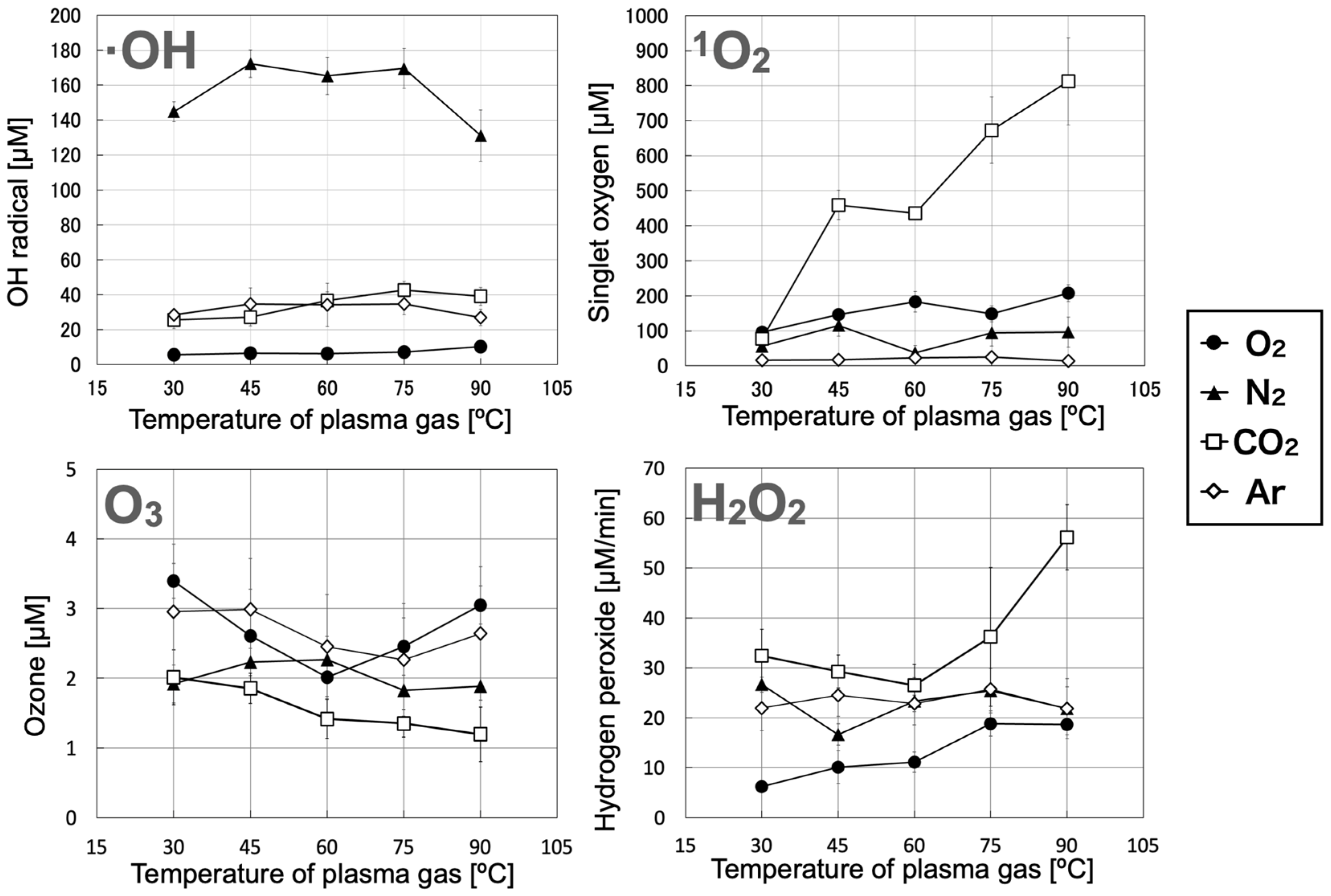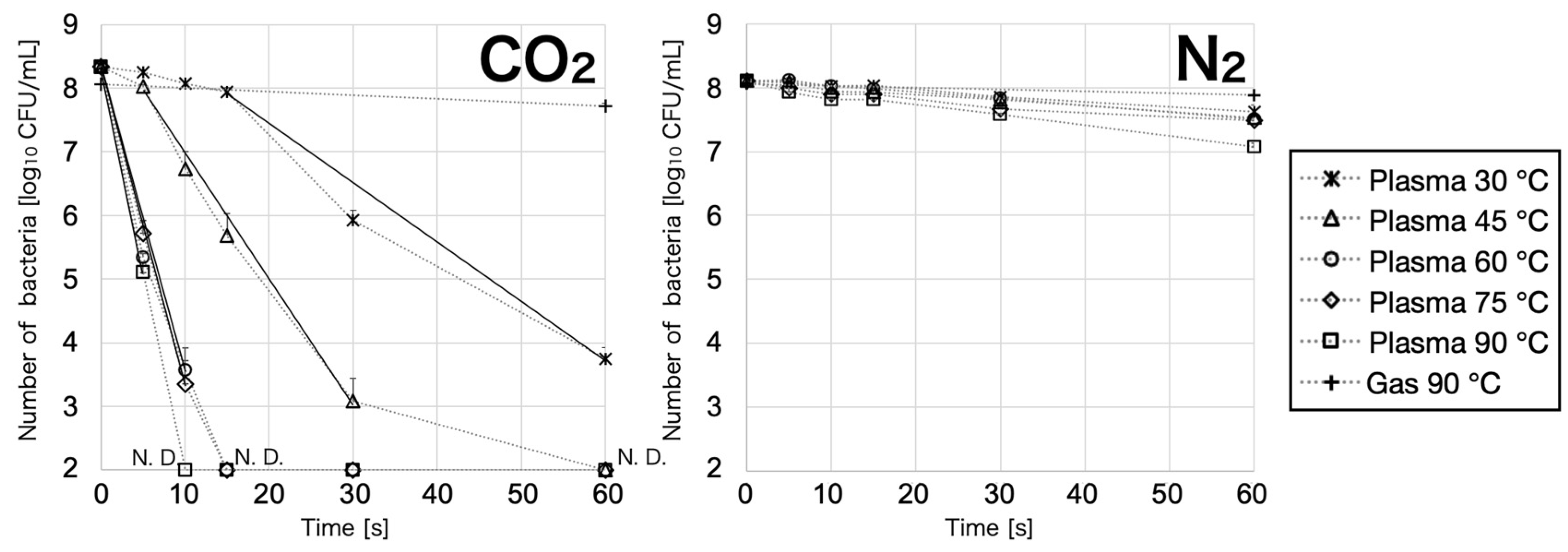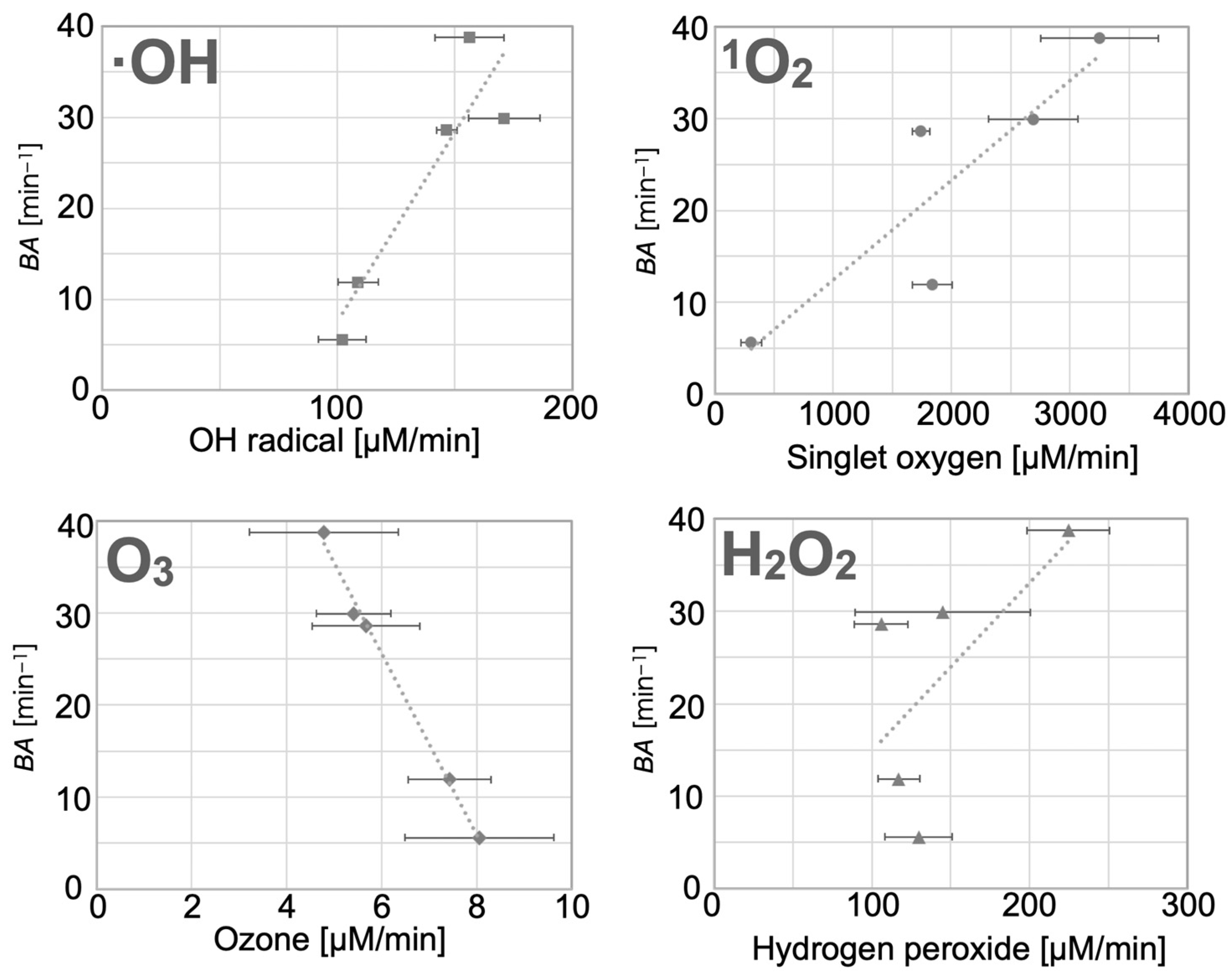Influence of Controlling Plasma Gas Species and Temperature on Reactive Species and Bactericidal Effect of the Plasma
Abstract
1. Introduction
2. Materials and Methods
2.1. Multi-Gas Temperature-Controllable Plasma Jet
2.2. Measurement of the Generated Reactive Species
2.3. Influence of Plasma Gas Temperature on Bactericidal Effect
3. Results
3.1. Measurement of Generated Reactive Species
3.2. Influence of Plasma Gas Temperature on Bactericidal Effect
3.3. Relationship between Bactericidal Effect and Reactive Species in Carbon Dioxide Plasma
4. Discussion
5. Conclusions
Author Contributions
Funding
Institutional Review Board Statement
Informed Consent Statement
Data Availability Statement
Acknowledgments
Conflicts of Interest
References
- Taylor, H.E. Inductively Coupled Plasma-Mass Spectrometry: Practices and Techniques; Academic Press: Cambridge, MA, USA, 2000; pp. 1–5. [Google Scholar]
- Kortshagen, U. Nonthermal plasma synthesis of semiconductor nanocrystals. J. Phys. D Appl. Phys. 2009, 42, 113001. [Google Scholar] [CrossRef]
- Maisch, T.; Shimizu, T.; Li, Y.F.; Heinlin, J.; Karrer, S.; Morfill, G.; Zimmermann, J.L. Decolonisation of MRSA, S. Aureus and E. Coli by cold-atmospheric plasma using a porcine skin model in vitro. PLoS ONE 2012, 7, e34610. [Google Scholar] [CrossRef] [PubMed]
- Nomura, Y.; Takamatsu, T.; Kawano, H.; Miyahara, H.; Okino, A.; Masaru, Y.; Takeshi, A. Investigation of blood coagulation effect of nonthermal multigas plasma jet in vitro and in vivo. J. Surg. Res. 2017, 219, 302–309. [Google Scholar] [CrossRef] [PubMed]
- Shimatani, A.; Toyoda, H.; Orita, K.; Hirakawa, Y.; Aoki, K.; Oh, J.; Shirafuji, T.; Nakamura, H. In vivo study on the healing of bone defect treated with non-thermal atmospheric pressure gas discharge plasma. PLoS ONE 2021, 16, e0255861. [Google Scholar] [CrossRef] [PubMed]
- Aida, M.; Iwai, T.; Okamoto, Y.; Miyahara, H.; Seto, Y.; Okino, A. Development of an ionization method using hydrogenated plasma for mass analysis of surface. J. Anal. At. Spectrom. 2018, 33, 578–584. [Google Scholar] [CrossRef]
- Iwai, T.; Kakegawa, K.; Aida, M.; Nagashima, H.; Nagoya, T.; Kanamori-kataoka, M.; Miyahara, H.; Seto, Y.; Okino, A. Development of a gas-cylinder-free plasma desorption/ionization system for on-site detection of chemical warfare agents. Anal. Chem. 2015, 87, 5707–5715. [Google Scholar] [CrossRef]
- Van Deynse, A.; Cools, P.; Leys, C.; De Geyter, N.; Morent, R. Surface activation of polyethylene with an argon atmospheric pressure plasma jet: Influence of applied power and flow rate. Appl. Surf. Sci. 2015, 328, 269–278. [Google Scholar] [CrossRef]
- Yoshimura, S.; Aramaki, M.; Otsubo, Y.; Yamashita, A.; Koga, K. Controlling feeding gas temperature of plasma jet with Peltier device for experiments with fission yeast. Jpn. J. Appl. Phys. 2019, 58, SEEG03. [Google Scholar] [CrossRef]
- Ishihara, D.; Noma, Y.; Stauss, S.; Sai, M.; Tomai, T.; Terashima, K. Development of a dielectric barrier discharge (DBD) cryo-microplasma. Plasma Sources Sci. Technol. Dev. 2008, 17, 035008. [Google Scholar] [CrossRef]
- Oshita, T.; Kawano, H.; Takamatsu, T.; Miyahara, H.; Okino, A. Temperature controllable atmospheric plasma source. IEEE Trans. Plasma Sci. 2015, 43, 1987–1992. [Google Scholar] [CrossRef]
- Kawano, H.; Takamatsu, T.; Matsumura, Y.; Miyahara, H.; Iwasawa, A.; Okino, A. Influence of gas temperature in atmospheric non-equilibrium plasma on bactericidal effect. Biocontrol Sci. 2018, 23, 167–175. [Google Scholar] [CrossRef] [PubMed]
- Takamatsu, T.; Hirai, H.; Sasaki, R.; Miyahara, H.; Okino, A. Surface hydrophilization of polyimide films using atmospheric damage-free multigas plasma jet source. Kagaku Kogaku Ronbunshu 2013, 39, 372–377. [Google Scholar] [CrossRef]
- Takamatsu, T.; Uehara, K.; Sasaki, Y.; Hidekazu, M.; Matsumura, Y.; Iwasawa, A.; Ito, N.; Kohno, M.; Azuma, T.; Okino, A. Microbial inactivation in the liquid phase induced by multigas plasma jet. PLoS ONE 2015, 10, e0132381. [Google Scholar] [CrossRef]
- Takamatsu, T.; Uehara, K.; Sasaki, Y.; Miyahara, H.; Matsumura, Y.; Iwasawa, A.; Ito, N.; Azuma, T.; Kohno, M.; Okino, A. Investigation of reactive species using various gas plasmas. RSC Adv. 2014, 4, 39901–39905. [Google Scholar] [CrossRef]
- Yanagawa, Y.; Kawano, H.; Kobayashi, T.; Miyahara, H.; Okino, A.; Mitsuhara, I. Direct protein introduction into plant cells using a multi-gas plasma jet. PLoS ONE 2017, 12, e0171942. [Google Scholar] [CrossRef] [PubMed]
- Kohno, M.; Yamada, M.; Mitsuta, K.; Mizuta, Y.; Yoshikawa, T. Spin-trapping studies on the reaction of iron complexes with peroxides and the effects of water-soluble antioxidants. Bull. Chem. Soc. Jpn. 1991, 64, 1447–1453. [Google Scholar] [CrossRef]
- Matsumura, Y.; Iwasawa, A.; Kobayashi, T.; Kamachi, T.; Ozawa, T.; Kohno, M. Detection of high-frequency ultrasound-induced singlet oxygen by the ESR spin-trapping method. Chem. Lett. 2013, 42, 1291–1293. [Google Scholar] [CrossRef]
- Ikai, H.; Nakamura, K.; Kanno, T.; Shirato, M.; Meirelles, L.; Sasaki, K.; Niwano, Y. Synergistic effect of proanthocyanidin on the bactericidal action of the photolysis of H2O2. Biocontrol Sci. 2013, 18, 137–141. [Google Scholar] [CrossRef] [PubMed]
- Abonti, T.R.; Kaku, M.; Kojima, S.; Sumi, H.; Kojima, S.; Yamamoto, T.; Yashima, Y.; Miyahara, H.; Okino, A.; Kawata, T.; et al. Irradiation effects of low temperature multi gas plasma jet on oral bacteria. Dent. Mater. J. 2016, 35, 822–828. [Google Scholar] [CrossRef]
- Pan, J.; Li, Y.L.; Liu, C.M.; Tian, Y.; Yu, S.; Wang, K.L.; Zhang, J.; Fang, J. Investigation of cold atmospheric plasma-activated water for the dental unit waterline system contamination and safety evaluation in vitro. Plasma Chem. Plasma Process. 2017, 37, 1091–1103. [Google Scholar] [CrossRef]
- Lee, M.H.; Park, B.J.; Jin, S.C.; Kim, D.; Han, I.; Kim, J.; Hyun, S.O.; Chung, K.H.; Park, J.C. Removal and sterilization of biofilms and planktonic bacteria by microwave-induced argon plasma at atmospheric pressure. New J. Phys. 2009, 11, 115022. [Google Scholar] [CrossRef]
- Smirnov, B.M. Excited Atoms. In Physics of Atoms and Ions, 1st ed.; Springer: New York, NY, USA, 2003; p. 148. [Google Scholar]
- Small-Warren, N.E.; Chiu, L.-Y.C. Lifetime of the metastable 3P2 anti 3P0 states of rare-gas atoms. Phys. Rev. A 1975, 11, 1777–1783. [Google Scholar] [CrossRef]
- Herron, J.T.; Green, D.S. Chemical kinetics database and predictive schemes for nonthermal humid air plasma chemistry. Part II. Neutral species reactions. Plasma Chem. Plasma Process. 2001, 21, 459–481. [Google Scholar] [CrossRef]
- Laroussi, M.; Leipold, F. Evaluation of the roles of reactive species, heat, and UV radiation in the inactivation of bacterial cells by air plasmas at atmospheric pressure. Int. J. Mass Spectrom. 2004, 233, 81–86. [Google Scholar] [CrossRef]
- Lezcano, I.; Rey, R.P.; Baluja, C.; Sánchez, E. Ozone inactivation of Pseudomonas Aeruginosa, Escherichia Coli, Shigella Sonnei and Salmonella Typhimurium in water. Ozone Sci. Eng. 1999, 12, 293–300. [Google Scholar] [CrossRef]
- Guo, J.; Huang, K.; Wang, J. Bactericidal effect of various non-thermal plasma agents and the influence of experimental conditions in microbial inactivation: A review. Food Control 2015, 50, 482–490. [Google Scholar] [CrossRef]




| Plasma Temp. (°C) | 30 | 45 | 60 | 75 | 90 |
|---|---|---|---|---|---|
| BA value (min−1) | 5.6 | 11.9 | 28.6 | 29.9 | 38.8 |
| Correlation Coefficient Value, R | ||||
|---|---|---|---|---|
| OH Radical | Singlet Oxygen | Ozone | Hydrogen Peroxide | |
| BA value | 0.914 | 0.885 | −0.997 | 0.623 |
Publisher’s Note: MDPI stays neutral with regard to jurisdictional claims in published maps and institutional affiliations. |
© 2021 by the authors. Licensee MDPI, Basel, Switzerland. This article is an open access article distributed under the terms and conditions of the Creative Commons Attribution (CC BY) license (https://creativecommons.org/licenses/by/4.0/).
Share and Cite
Suenaga, Y.; Takamatsu, T.; Aizawa, T.; Moriya, S.; Matsumura, Y.; Iwasawa, A.; Okino, A. Influence of Controlling Plasma Gas Species and Temperature on Reactive Species and Bactericidal Effect of the Plasma. Appl. Sci. 2021, 11, 11674. https://doi.org/10.3390/app112411674
Suenaga Y, Takamatsu T, Aizawa T, Moriya S, Matsumura Y, Iwasawa A, Okino A. Influence of Controlling Plasma Gas Species and Temperature on Reactive Species and Bactericidal Effect of the Plasma. Applied Sciences. 2021; 11(24):11674. https://doi.org/10.3390/app112411674
Chicago/Turabian StyleSuenaga, Yuma, Toshihiro Takamatsu, Toshiki Aizawa, Shohei Moriya, Yuriko Matsumura, Atsuo Iwasawa, and Akitoshi Okino. 2021. "Influence of Controlling Plasma Gas Species and Temperature on Reactive Species and Bactericidal Effect of the Plasma" Applied Sciences 11, no. 24: 11674. https://doi.org/10.3390/app112411674
APA StyleSuenaga, Y., Takamatsu, T., Aizawa, T., Moriya, S., Matsumura, Y., Iwasawa, A., & Okino, A. (2021). Influence of Controlling Plasma Gas Species and Temperature on Reactive Species and Bactericidal Effect of the Plasma. Applied Sciences, 11(24), 11674. https://doi.org/10.3390/app112411674






